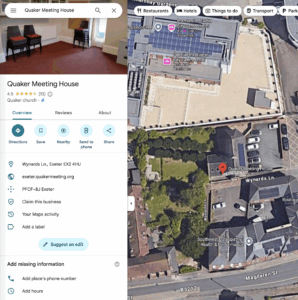Thinking about the language you use...
I’m sure you’ve heard the old truism about “ass-uming”. But our society actually trains us to make various assumptions, usually based on “normal” behaviour and lifestyles. The language we use is no different.
Picture this: you are a volunteer manager. Your charity is holding some event – perhaps a fundraiser, perhaps a celebration, but the whole team is going to be there.
Mrs Smith, one of your recent volunteers, approaches you to ask about bringing a +1.
You, wanting to be encouraging and welcoming, warmly declare “Of course you can bring your husband!”

Do you see the problem?
Many people will, with the best of intentions, assume that Mrs Smith being married means she has a husband. But Mrs Smith might have a wife, or a nonbinary spouse, or even be divorced and chose to keep her married honorific.
Furthermore, in the above example we are assuming that if she is bringing a +1 to the event, it will be her spouse. But, even if she has a husband, she might want to bring someone else. Perhaps her husband hates parties so she brings a friend, or relative – or maybe she has more than one partner and wishes to bring one she isn’t married to.
And if any of these are true, and Mrs Smith was not asking to bring her husband, your attempt to be welcoming will actually be very alienating for her. She has been put on the spot and now has to quickly weigh the situation up and decide what to do.
Does she correct you?
That is likely to be awkward, especially if you respond by being defensive or over-apologising. And, given that you’ve made it clear that you think her having a husband and wanting to bring him is the “natural” situation, will you react badly to finding out her lived experience is different to what you expect? Would this reveal cause you to be unfriendly and turn this place into an unpleasant work environment? Will she lose her position? In the worst case, admitting the truth about what she meant might actually put her wellbeing and life at risk.
All too often, Mrs Smith will force a smile, say something like “Oh, I’ll ask them”, and then drop the matter, never to be raised again. It’s safer.
Entirely without meaning to, and possibly without realising, you have put a barrier between Mrs Smith and yourself, and by extension your organisation – just because of the language you have used. She will likely hold back and not integrate fully. She may hesitate to talk about herself, not bring her family/friends along, and refrain from forming close relationships with the rest of the team.
And the more times this happens, the more casual assumptions you make about her which are incorrect, the thicker that barrier gets.
What should you do instead?
Well, as you’ve likely guessed from the title, we need to deliberately avoid making assumptions. Which usually takes mindfulness and a lot of practice, because our society has trained us to do the opposite in many areas.
Let’s imagine the same scenario. But this time, you don’t make any guesses about who Mrs Smith wants to bring. You don’t mention a husband, or even a partner.
Instead, you warmly say “Of course! I just need to know their name and any accessibility needs or dietary requirements.”
Now, it doesn’t matter who Mrs Smith has in mind. If she has a wife, she can bring her. If she has a boyfriend, she can bring him. If she has a friend, she can bring them. Meanwhile, you have the information you need to be welcoming to this person, plus an identifier to save that by.
Because really, does it matter to you (or your organisation) who this person is to Mrs Smith? You don’t need to worry about that. You just need to know enough about them to properly host.
Training your brain away from assumptions...
That’s the two steps of training your brain away from making assumptions:
Identify if you need to know a piece of information
Identify if you do know that information
Regarding the first: satisfying curiosity is not a need. Even harmless questions get very tiring when you have to answer them over and over, and when you are operating from a place of privilege it’s difficult to judge whether a question is actually harmless. If the only reason you want to ask is because you are curious or because not knowing is bothering you in some way, don’t ask.

Similarly, changing your language/approach can reduce the information you need to ask for. For example, if rather than “sir” and “lady” you use gender neutral terms like “customer”, “volunteer”, etc., you don’t need to ask someone’s pronouns or question them on what gendered terms they are comfortable with. You can just use the same language for everyone. (This also involves less thinking and remembering, at least once you’ve practised enough that it’s automatic.)
If you do need to know a piece of personal information, avoid assumptions when asking. Rather than going “you’re a guy, right?” or even “are you a man or a woman?”, instead ask something like “what’s your biological sex?”. Or, if what you want is to know what pronouns to use when talking about them, ask that – “What are your pronouns?”.
By specifying the exact piece of information you want but keeping the question open, you leave space for all kinds of lived experiences while keeping it easy for the person to answer.
Which is what we do all the time for most pieces of information. When meeting someone for the first time, it would be thought very odd to ask “So, is your name ‘John’ or something else?” rather than just asking “What’s your name?”. We’re just trying to be consistent, regardless of what information we’re requesting.
Applying it within your organisation...
To apply this to an organisation, go over the forms, stock questions, and personal data tables that you use. Look at each piece of information you ask for, and consider whether you actually need that information.
Does it matter what the person’s genitals look like? (This is, in fact, what you are asking when you start your form with “male or female?”.) Similarly, is their gender identity relevant? Do you need a full legal name, or is a nickname fine? Perhaps you don’t even need a name, and can simply apply a number to them.
The same goes for ethnicity, health conditions, education… anything. What are you using this information for? Do you think that use justifies asking for this piece of personal information? If so, consider adding a brief explanation to your form to inform and reassure people. If not, simply remove the question.
Considering the questions you want to keep, make sure that you are limiting assumptions and making space for multiple lived experiences. Have a write-in option for every question. Add as many selectable options as you think might be helpful without making your form unreasonably long. And be sure to use universal terms that don’t project a gender, age, orientation, ethnicity, or anything else onto the person.
I won’t pretend this isn’t work; it is. But it gets easier the more you practice, and even at its hardest, it’s work well worth doing. By avoiding presenting people with stock boxes they would have to squish themselves to fit into, and instead of giving them space to be themselves, your life and organisation will be enriched by all kinds of interesting people.

Lee Heywood
Volunteer






